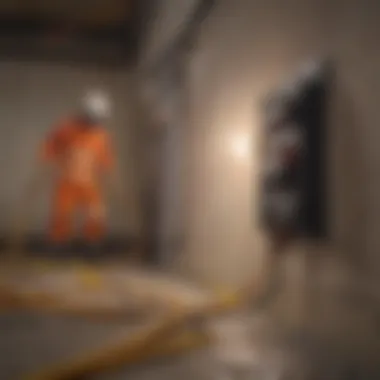Fixing a Tripped Breaker: A Comprehensive Guide


Intro
Electrical systems are a fundamental part of residential life, providing power for lighting, appliances, and devices. Despite their importance, they can occasionally fail. Among common issues, a tripped breaker ranks high. This situation often causes frustration and confusion for homeowners. An understanding of why breakers trip and how to address the problem is crucial for maintaining a safe home.
In this guide, we will explore the aspects of tripped breakers, from identifying various causes to ensuring safe practices while resetting one. Homeowners, or anyone curious about their electrical systems, will find it useful to know the specifics.
In addition, knowing when to seek professional help can save time and prevent potential hazards. With this information, individuals can manage their home electricity systems more effectively.
Foreword to Tripped Breakers
Understanding tripped breakers is essential for anyone who relies on electrical systems within a home. A tripped breaker can signify more than just an inconvenience; it serves as a critical safety mechanism designed to prevent electrical overloads and potential fires. Thus, grasping the intricacies of circuit breakers can offer significant benefits to homeowners. By knowing how to identify and address a tripped breaker, individuals can promote a safer environment while reducing the risk of damage to their electrical appliances.
Understanding Circuit Breakers
Circuit breakers are electrical switches that automatically interrupt the flow of electricity when there is an overload or short circuit. They function as a safety net, protecting electrical systems from excessive current flow. Each breaker is designed to handle a specific load based on the wiring and devices attached to it. When the load exceeds the breaker's capacity, it trips, cutting off power to the circuit.
To put it simply, circuit breakers are the first line of defense against electrical failures. Knowing how they operate can help individuals troubleshoot issues more effectively. It is also crucial to understand their ratings and types, such as single-pole or double-pole breakers, as this knowledge enables homeowners to make informed decisions regarding their electrical systems.
Common Reasons for Tripping
Several factors can lead to a breaker tripping. Understanding these causes can assist in preventing future occurrences. Some common reasons include:
- Overloaded circuit: When too many devices draw power from the same circuit, the load may exceed the circuit breaker's capacity.
- Short circuit: This occurs when a hot wire touches a neutral wire or another hot wire, creating an uncontrolled flow of electricity. Short circuits pose a significant safety hazard.
- Ground fault: Similar to a short circuit, a ground fault occurs when electricity finds an unintended path to the ground, often through a wet or damaged area. This condition can trigger a breaker to trip.
- Faulty appliances: A malfunctioning appliance can cause a circuit to overload and subsequently trip the breaker. Regular maintenance and inspection of appliances can mitigate such risks.
By being aware of these factors, homeowners can take proactive measures to ensure their electrical systems remain functional and safe. Addressing the issues surrounding tripped breakers can contribute to overall home safety and reduce unnecessary electrical repairs.
Signs of a Tripped Breaker
Recognizing the signs of a tripped breaker is crucial for any homeowner. It helps prevent further damage to electrical systems and ensures safety in living spaces. Ignoring these signs can lead to overloaded circuits and potential hazards. By promptly identifying and addressing issues, one can maintain a reliable and safe electrical environment.
Visual Indicators
The first step in identifying a tripped breaker often involves visual cues. The most straightforward method is to inspect the circuit breaker panel. Look for switches that are in the off position or one that has moved to a middle position, indicating it has tripped. Furthermore, check for any signs of discoloration or burn marks around the breakers. These physical signs can indicate overheating or damage.
Additionally, flickering lights in certain rooms or appliances that suddenly stop working can signal a tripped breaker. If you notice that multiple lights or devices are unresponsive, it is worthwhile to investigate the circuit.
- Panel Inspection:
- Light and Appliance Behavior:
- Look for switches that are not fully in the 'on' position.
- Check for damaged or singed breakers.
- Notice any blinking or flickering lights.
- Appliances shutting off unexpectedly also point to electrical issues.
Auditory Signs
In addition to visual signs, auditory indications can help in determining if a breaker has tripped. Listen for unusual sounds coming from your electrical panel. A loud popping or a crackling noise could suggest problems within the circuit, hinting at issues needing prompt attention.
Sometimes, breaking noises can be heard from malfunctioning appliances or devices as well. If any appliance is associated with a strange or unfamiliar sound, this might be a sign they are tripping the circuit.


- Sounds to Watch for:
- Popping or crackling near the breaker panel.
- Unusual sounds from malfunctioning devices.
Identifying these auditory signs is as critical as the visual indicators. Addressing these symptoms early on can mitigate risks and enhance the safety of your electrical systems.
Initial Safety Precautions
When dealing with electrical systems, safety is of paramount importance. Tripped breakers can be a symptom of larger underlying issues, so it is essential to approach the situation with caution. Implementing appropriate safety measures can prevent serious injuries or damage to your property. Understanding the essential initial safety precautions will help you to ensure a secure environment as you address the problem of a tripped breaker.
Ensuring Personal Safety
Before you begin any work on your electrical system, confirm that you are adequately prepared to ensure personal safety. Here are some key steps to follow:
- Turn Off All Appliances: Unplug any devices connected to the circuit to avoid potential electric shock while resetting the breaker.
- Wear Proper Gear: Use gloves and non-conductive shoes to reduce the risk of electric shock.
- Use a Flashlight: If darkness is present in the area, use a flashlight instead of turning on ceiling lights. This prevents additional strain on the circuit and diminishes the risk of further tripping.
- Keep Tools Dry: Make sure that any tools you are using are not wet. Moisture increases conductivity and increases risk.
Always remember that working on live circuits can be dangerous. If you are unsure or uncomfortable, it may be best to consult a professional.
Preparing the Environment
Properly preparing your environment is another critical step to ensure safety when addressing a tripped breaker. This phase involves creating a clean workspace conducive to safe electrical work.
- Clear the Area Around the Circuit Breaker Panel: Remove any obstructions surrounding the circuit breaker panel to give yourself space to work. You do not want to trip over items in the dark.
- Check for Water Exposure: Before beginning, ensure that the environment is dry. If there has been flooding or water exposure, avoid touching any electrical systems until a professional evaluates the situation.
- Inform Others: Let those in your household know that you are working on the electrical system. This prevents someone from inadvertently using a device that could cause the breaker to trip again.
- Have a Plan: Before proceeding, create a step-by-step plan for resetting the breaker. Knowing what to do helps maintain focus and safety while you work.
By adhering to these safety protocols, you can significantly reduce the risk of accidents while addressing a tripped breaker. By prioritizing personal safety and preparing the environment, you pave the way for a successful intervention.
Steps to Fix a Tripped Breaker
Fixing a tripped breaker is more than a mere act of restoring power. It involves understanding the underlying issues that may cause interruptions and ensuring that safety is prioritized throughout the process. Knowing how to effectively address a tripped breaker can save time, reduce potential hazards, and increase your confidence in managing your home’s electrical system.
Locating the Circuit Breaker Panel
To address a tripped breaker, the first step is to find your circuit breaker panel. This is typically located in places such as basements, garages, or utility rooms. In some homes, it may be found in closets or hallways. If you are unsure about its location, it is advisable to refer to the home’s layout if available or check with the previous homeowner or property documentation. The panel is usually a metal or plastic box with a door that can be opened to reveal the switches inside.
Identifying the Tripped Breaker
After locating the circuit breaker panel, the next task is to identify which specific breaker has tripped. You should look for a switch that is in the 'off' position or that is physically different from the others, often moved to a halfway position between on and off. Most panels will have labels next to each breaker that indicate which area or appliance they control. If your panel lacks clear labeling, taking a moment to test the breakers may be necessary. This knowledge can prevent confusion in future instances when troubleshooting electrical issues.
Resetting the Breaker
Once you have identified the tripped breaker, resetting it is the next logical step. First, ensure that you have addressed any potential causes for the trip, like unplugging faulty appliances or fixing overloaded circuits.
To reset the breaker, simply flip the switch back to the 'on' position. You may feel some resistance initially, but this is normal. If the breaker trips again immediately, it could indicate a more significant issue that requires further investigation.
Resetting the breaker does not mean problems are resolved. Persistent tripping indicates a deeper issue that should be evaluated.
Following these steps helps to efficiently address tripped breakers, an issue commonly encountered in residential settings. Understanding and executing these steps will empower homeowners to manage their electrical systems more effectively.
After Resetting the Breaker


After attempting to reset a tripped circuit breaker, it becomes crucial to evaluate the electrical system's overall functionality. This step is essential not just for safety but also for ensuring long-term reliability of the electrical system. Without proper testing and monitoring, the risk of future tripping events remains high. Understanding the subsequent actions after resetting the breaker serves as a method to prevent recurrent issues and ensure that the electrical infrastructure is stable and effective.
Testing Electrical Systems
Once the breaker has been reset, it is important to test the associated electrical systems. This involves checking outlets and appliances that are connected to the circuit. Here are some steps to ensure all systems are functioning appropriately:
- Use a Multimeter: This tool can be used to measure voltage at sockets and appliances. It helps confirm that power is flowing as expected.
- Check Each Outlet: Plug in devices to verify they operate correctly. Look for any flickering lights or unresponsive gadgets, which can indicate further issues.
- Observe for Heat: Feel for warmth around outlets and appliances. Excessive heat can be a sign of electrical problems that need addressing immediately.
- Test GFCI Outlets: Ground Fault Circuit Interrupter outlets should be tested to ensure they are working properly. Press the "test" button, and ensure the reset works afterwards.
These actions help in identifying if everything is back to normal after a reset. By thoroughly testing, one can ensure that the repairs performed were effective and that no further issues persist.
Monitoring for Further Issues
Once the electrical systems are tested, ongoing monitoring is necessary. This process will help in identifying any signs of recurring problems. Here are some considerations to keep in mind:
- Regular Observations: Watch for any unusual behaviors in the electrical system, such as repeated breaker trips or dimming lights, which may signal upcoming failures.
- Record Keeping: Maintain a log of tripped breakers and any associated events leading up to it. This can help in identifying patterns or common factors that cause the problems.
- Scheduled Maintenance: Routine checks by yourself or professionals can catch issues early. Consider having an electrician review the system annually or biannually.
"Electrical safety is about more than just fixing a tripped breaker. It involves vigilance in monitoring and maintaining your systems to prevent issues before they require substantial repairs."
Monitoring is an often-overlooked aspect of electrical maintenance that can save homeowners both money and time in the long run. It fosters a proactive approach rather than a reactive one, which is vital in maintaining a safe and functional home environment.
Troubleshooting Persistent Trip Issues
Persistent tripping of circuit breakers can be frustrating and may indicate more serious issues within your electrical system. Addressing these recurrent interruptions is critical, not only for convenience but also for safety. Failure to resolve these problems could lead to hazards such as electrical fires or costly damage to home appliances.
When a breaker trips frequently, it is essential to understand that the circuit is responding to a problem. This may stem from several underlying issues, such as overloading the circuit, short circuits, or faulty wiring. Identifying these issues quickly can save a homeowner considerable time and expense in the long run.
Identifying Underlying Problems
To effectively troubleshoot persistent trips, the first step is identifying the underlying problem. A common cause of recurrent tripping is overload. This occurs when too many devices are drawing power from a single circuit. It's important to assess which devices are connected, as certain high-draw appliances can easily exceed the limitation of a circuit.
Short circuits can also cause frequent trips. This happens when a hot wire contacts a neutral wire, resulting in a surge of current. It is crucial to look for signs such as burnt smell or discoloration around outlets. Sometimes, problems might arise from outdated or damaged wiring. An aged electrical system may require an upgrade to handle modern energy demands.
Some steps to identify issues include:
- Inspecting circuit connections for wear and tear.
- Looking for unusual behaviors in appliances, like flickering lights or devices that overheat.
- Reviewing your usage patterns to determine if there's a consistent overload.
Testing Electrical Appliances
Once potential underlying issues are identified, the next step involves testing specific electrical appliances. Begin by unplugging all devices connected to the tripped circuit. Once the circuit is clear, reset the breaker. If it remains stable, plug devices back in one by one to identify the culprit. This systematic approach can help isolate the faulty appliance.
When testing, don’t forget:
- Inspect the power cords for any signs of damage that may cause shorts.
- Pay attention to any appliance that consistently causes the breaker to trip, which may indicate internal faults.
- Check the ratings of appliances to ensure they do not exceed the circuit capacity.
It is advisable to be cautious during this process. If an appliance trips the breaker repeatedly, consider consulting the manufacturer or an electrician. Identifying and addressing these persistent issues promptly can preserve both the safety and efficiency of your home’s electrical system.
When to Contact a Professional


Dealing with electrical issues can be daunting, especially if those issues persist despite troubleshooting efforts. Knowing when to enlist the help of a professional electrician is crucial. This section will provide insight into recognizing problematic symptoms and the benefits of trusting trained professionals.
Recognizing Complex Issues
Sometimes, a tripped breaker can be a symptom of deeper electrical problems. These complex issues may include faulty wiring, overloaded circuits, or malfunctioning electrical appliances. It is essential to recognize the signs that indicate these challenges. For example, frequent tripping, flickering lights, or burning odors can suggest serious conditions that require expert evaluation. If the breaker trips immediately after resetting, this may demonstrate an underlying fault that cannot be diagnosed through basic troubleshooting.
In such instances, attempting to fix these problems alone can lead to dangerous situations, such as electrical fires or severe shock. If the complexity of the issue increases, it is better to contact a professional rather than risk personal safety or further damage to the electrical system.
Finding a Qualified Electrician
Choosing the right electrician is vital for effective resolution of electrical problems. There are a few key points to keep in mind when searching for a qualified professional. First, ensure they possess appropriate licences and certifications. This verifies that they have the necessary skills and knowledge to deal with various electrical issues.
Next, consider seeking recommendations from trusted sources, such as friends or relatives. Online reviews can provide further insight into the electrician's reputation. Additionally, request estimates from multiple electricians prior to making a final decision. Comparing these bids can help determine the best fit for your needs.
Ultimately, finding a competent and reputable electrician ensures that the complexities of electrical systems are handled correctly, emphasizing safety and peace of mind. Trusting a professional allows homeowners to avoid wasted effort and focus on maintaining their living space with confidence.
Prevention of Future Issues
Preventing future issues with circuit breakers is crucial for both safety and reliability within an electrical system. Tripping breakers are not just nuisances; they indicate underlying problems that may escalate if taken lightly. By adopting preventive measures, homeowners can minimize the frequency of trips and ensure their electrical systems run smoothly. This section will examine the significance of regular maintenance and upgrading electrical systems, both of which play key roles in enhancing system performance.
Regular Maintenance Tips
Regular maintenance helps in identifying potential issues before they cause serious problems. Simple tasks can form a solid routine. Here are some practical maintenance tips:
- Routine Inspections: Regularly check your circuit breaker panel. Look for any signs of wear, corrosion, or moisture. These can indicate significant underlying issues.
- Cleanliness: Dust and dirt can accumulate around electrical components. Keeping them clean helps ensure optimal performance and prevents overheating.
- Check Connections: Loose wires can lead to arcing, causing breakers to trip frequently. Ensure all connections are tight and secure.
- Test Breakers: Periodically testing circuit breakers can reveal issues early. Most breakers have a test button that simulates a fault condition. Use this to ensure they respond properly.
These practices not only extend the life of your electrical system but also improve safety.
Upgrading Electrical Systems
Upgrading electrical systems is another effective way to prevent trips. Older systems may not handle modern electrical loads efficiently. Here are considerations for upgrading:
- Increased Load Capacity: Homeowners may need to upgrade their systems to accommodate new appliances or technologies. Make sure the electrical panel is rated for the current demands.
- Dedicated Circuits: Adding dedicated circuits for high-capacity appliances can prevent overload on shared circuits. This is vital for items like refrigerators and washing machines.
- Professional Evaluation: Engage an electrician for a thorough evaluation of the existing system, especially in older homes. This can highlight necessary upgrades that align with current building codes.
In summary, implementing regular maintenance and considering upgrades are key strategies in preventing future breaker trips. These actions not only enhance safety but also contribute to the longevity and efficiency of your electrical systems.
The End
Understanding how to handle a tripped breaker is an essential skill for homeowners and individuals interested in maintaining their electrical systems. The steps outlined throughout this article provide a clear framework for addressing this common issue. It is important to recognize not just the immediate action needed to reset the breaker but also the implications of recurrent tripping. A breaker that frequently trips often suggests underlying problems that must be dealt with to prevent potential hazards.
The benefits of following the recommended practices include enhanced safety, reduced likelihood of property damage, and the peace of mind that comes with knowing your electrical system is functioning properly. Regular checks, understanding the reasons for trips, and knowing when to call a professional can help ensure that you maintain a safe living environment.
Furthermore, fostering a proactive mindset toward electrical maintenance encourages a deeper comprehension of how our homes operate. This empowers homeowners with the knowledge to prevent issues rather than just reacting to them.
"Being proactive in home maintenance can prevent small issues from becoming major problems."
Summary of Key Points
- A tripped breaker is often an indication of electrical overload or underlying issues in the circuit.
- Initial safety precautions are critical before addressing a tripped breaker.
- Identifying the reasons for the trip and monitoring appliances can help resolve issues.
- Regular maintenance is key to preventing future disruptions in your electrical system.
Encouragement for Further Learning
For readers seeking a more comprehensive understanding of electrical systems, consider delving into various resources that highlight electrical safety and maintenance tips. Websites like Wikipedia provide in-depth information on circuit breakers and their functions. Engaging in online forums, such as Reddit, can also offer practical insights from fellow homeowners. Additionally, local workshops on electrical safety can enhance personal knowledge and skills. Taking these steps not only improves your immediate situation but also extends your knowledge base for future home improvement endeavors.







